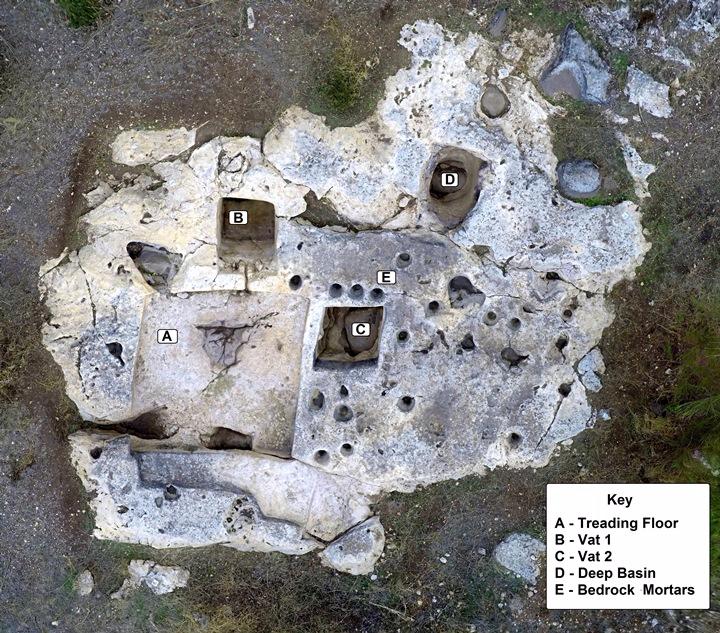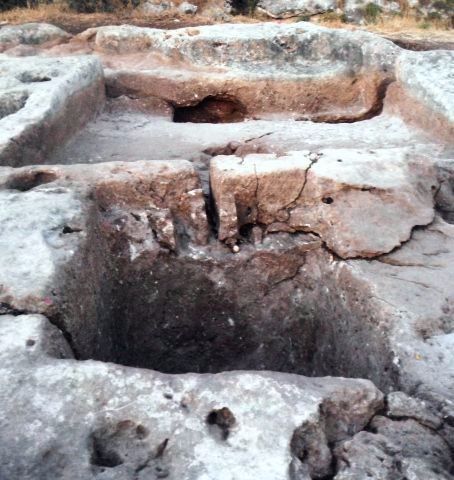 Edit article
Edit articleSeries
The Story of Naboth’s Vineyard and the Ancient Winery in Jezreel

Naboth refuses King Ahab his vineyard. Thomas Matthews Rooke (1842–1942), Russell-Cotes Art Gallery & Museum
The Story of Naboth’s Vineyard in Jezreel
The well-known story of Naboth’s vineyard begins:
מלכים א כא:א כֶּרֶם הָיָה לְנָבוֹת הַיִּזְרְעֵאלִי אֲשֶׁר בְּיִזְרְעֶאל אֵצֶל הֵיכַל אַחְאָב מֶלֶךְ שֹׁמְרוֹן: כא:ב וַיְדַבֵּר אַחְאָב אֶל נָבוֹת לֵאמֹר תְּנָה לִּי אֶֽת כַּרְמְךָ וִיהִי לִי לְגַן יָרָק כִּי הוּא קָרוֹב אֵצֶל בֵּיתִי וְאֶתְּנָה לְךָ תַּחְתָּיו כֶּרֶם טוֹב מִמֶּנּוּ אִם טוֹב בְּעֵינֶיךָ אֶתְּנָה לְךָ כֶסֶף מְחִיר זֶה: כא:ג וַיֹּאמֶר נָבוֹת אֶל אַחְאָב חָלִילָה לִּי מֵֽי-הֹוָה מִתִּתִּי אֶת נַחֲלַת אֲבֹתַי לָךְ:
1 Kings 21:1 Naboth the Jezreelite owned a vineyard in Jezreel, near the hêḵal of King Ahab of Samaria. 21:2 Ahab said to Naboth, “Give me your vineyard, so that I may have it as a vegetable garden, since it is right next to my house, I will give you a better vineyard in exchange; or, if you prefer, I will pay you the price in money.” 21:3 But Naboth replied, “YHWH forbid that I should give up to you what I have inherited from my fathers!”
It continues with Ahab expressing his bitterness about Naboth’s response, and his wife, Queen Jezebel, arranging false witnesses to charge Naboth with blasphemy, a capital offense. Upon Naboth’s execution, she presents the vineyard to Ahab, spurring the prophet Elijah to make his famous declaration (v. 19), “Have you murdered and then inherited?!” (הֲרָצַחְתָּ וְגַם יָרָשְׁתָּ) and to inform Ahab that he, his wife, and his dynasty have been condemned by God.
The fulfilment of this prophecy is narrated in 2 Kings 9, which describes Jehu’s assassination of Joram son of Ahab near Naboth’s plot in Jezreel. After Joram is killed, Jehu explains his actions to his men:
ט:כה וַיֹּ֗אמֶר אֶל בִּדְקַר [שָׁלִשׁוֹ] שָׂא הַשְׁלִכֵהוּ בְּחֶלְקַת שְׂדֵה נָבוֹת הַיִּזְרְעֵאלִי כִּֽי זְכֹר אֲנִי וָאַתָּה אֵת רֹכְבִים צְמָדִים אַֽחֲרֵי אַחְאָב אָבִיו וַֽי-הֹוָה נָשָׂא עָלָיו אֶת הַמַּשָּׂא הַזֶּה: ט:כו אִם לֹא אֶת דְּמֵי נָבוֹת וְאֶת דְּמֵי בָנָיו רָאִיתִי אֶמֶשׁ נְאֻם יְ-הֹוָה וְשִׁלַּמְתִּי לְךָ בַּחֶלְקָה הַזֹּאת נְאֻם יְ-הֹוָה וְעַתָּה שָׂא הַשְׁלִכֵהוּ בַּחֶלְקָה כִּדְבַר יְ-הֹוָה:
9:25 He ordered his officer Bidkar, “Pick him (Joram) up and throw him into the field of Naboth the Jezreelite. Remember how you and I were riding side by side behind his father Ahab, when YHWH made this pronouncement about him: 9:26 ‘I swear, I have taken note of the blood of Naboth and the blood of his sons yesterday—declares YHWH. And I will requite you in this plot—declares YHWH.’ So pick him up and throw him unto the plot in accordance with the word of YHWH.”
A key feature of both parts of the story is Naboth’s plot or vineyard. What light can archaeology shed on this vineyard and its place in Jezreel?

The Fertile City of Jezreel
The ancient site of Jezreel was built on a rocky spur in the foothills of Mount Gilboa, overlooking the fertile Jezreel Valley, which was named after it.[1] The city sits opposite Shunem, with its rich, agricultural fields,[2] and by a nearby a perennial spring, mentioned in 1 Samuel 29:1 (the story of Saul’s final battle):
וְיִשְׂרָאֵל חֹנִים בַּעַיִן אֲשֶׁר בְּיִזְרְעֶאל.
Israel was encamping at the spring in Jezreel.

The spring, which still exists today, provided water for both city dwellers and travellers, and was guarded by the recently discovered lower city of Jezreel (Tel ‘Ein Yizre’el). The rich land surrounding Jezreel provided ideal conditions for agriculture and grazing.
Excavations and Findings of the LiDAR Scan
The present Jezreel expedition, which I (Norma Franklin, University of Haifa) am co-directing with Jennie Ebeling (University of Evansville, Indiana), was founded in 2012 with the aim of surveying, excavating[3] and documenting the site of greater Jezreel over a long period of time [4]
A LiDAR (Light Detection and Ranging) scan was commissioned and a large selection of maps, aerial photographs and archival material was utilized prior to a traditional landscape survey conducted in June of 2012. A three-to-four square kilometer area to the west, north, and east of the upper tel of Jezreel was divided into survey areas based on the LiDAR model. More than 360 features were documented, among them 57 agricultural installations such as wine and olive oil presses.[5]

Also, over 100 rock-cut bottle-shaped pits, scattered over the summit of the hill, were found. Some were hewn for use as cisterns, and others as temperate underground storage pits.[6] Likely some of these were used to store wine; at ancient Gibeon, 63 rock-cut, bottle-shaped storage pits or cellars, one with in-situ wine jars, served just this purpose.[7]
Evidence of a Vineyard?
Vineyards do not leave archaeological remains, but circumstantial evidence suggests that Jezreel likely had one. Kibbutz Yizre’el alerted us to the fact that they had independently conducted a soil analysis and found a plot of land with proper quality for growing grapes, whereas the soils in the fields further west were found to be better suited to growing olives.[8]This plot is immediately north of an ancient winery, and during the biblical period wine processing areas were generally located next to vineyards.[9]
The Winery Complex

In Area K, a particularly impressive installation was carved into the limestone bedrock at the foot of the hill of Jezreel, north-east of the area excavated in the 1990s, and directly south of a large fertile terrace that sloped towards the spring of Jezreel. The complex covers an area of approximately 12 square meters, and its characteristics indicate that it was a winery:
- A square rock-cut treading floor measuring 3.2 meters on each side
- Two adjacent rock-cut vats each ca. 1.3 meters square and over one meter deep.
- The treading floor, which slopes down toward a vat, Vat 1, and is connected to it by a 15 centimeter long, 5 centimeter wide, rock-cut channel.
- A sump for collecting liquids in the northwest corner of Vat 1.
- Another vat, Vat 2, located to the east of the treading floor but not connected to it.
- A deep circular basin, northeast of the treading floor, ca. 1 meter in diameter, that possibly functioned as another vat.
How the Winery Worked

The wine in Jezreel was made by traditional grape-stomping. The benefit of treading grapes by feet as opposed to using a wine press is that it prevents the pips (little grape seeds) from being smashed and changing the taste of the wine. A roughly triangular depression in the center of the treading floor was probably used to collect the grape skins, pips and stalks that formed a block around which the juice flowed toward the primary fermentation vat (Vat 1).
The young, unfiltered grape juice, called “must,” would have started to ferment as soon as it came into contact with the yeast that occurs naturally on the grape skins. Primary fermentation would have continued in Vat 1 for a number of days; a number of ancient sources specify that this first stage took place for three days in open jars or in the collection vat.[10] The wine was then strained into jars that were stored in a cool place for secondary fermentation. The bottle-shaped pits found at Jezreel are identical with those at Gibeon, and were ideal temperate storage places for secondary fermentation.
The Jezreel winery was typical for this area and general period. An extensive survey of 117 wine treading areas southwest of Jezreel was conducted in the 1960s. The majority consisted of a rectangular treading floor with a rectangular vat, similar to the Jezreel winery, and were usually located outside of a village and cut into the edge of the bedrock outcrop next to the fields.[11]
The Date of the Jezreel Winery
It is difficult to date ancient rock-cut agricultural installations,[12] and the winery in Area K is no exception. During the time it was in use, any pottery or other artifacts that could help date the complex would have been cleared away on a regular basis because they would have interfered with wine production.[13] The one thing we can say about the dating is that it is pre-Hellenistic, since from the Hellenistic period onwards wineries used a beam or screw press, and the Jezreel winery does not.[14]
Comparison with Samaria
As Jezreel was an important city in ancient Israel, it is likely that winery dates from this period. This would also fit with the current assumptions about the winery in the capital, Samaria, where a 5 by 10 meter treading floor and some smaller treading areas were excavated by the Harvard Excavations in the early 1900s. Their dating has been recently reevaluated and attributed to the earliest phase of building (called “Building Period 0” since it is the earliest layer), 10th or 9th century BCE.[15]
A Valuable Commodity for a King
Evidence from Assyrian texts show that at the same time that Naboth is pictured as tending his grapes (Omride period), Ashurnasirpal II of Assyria is described as having provided 10,000 wineskins at an inaugural party at his new palace in Calah, where he wined and dined 70,000 guests.[16] Although we don’t have textual evidence of quite such lavish entertaining in ancient Israel, wine also flowed freely at the Israelite capital, Samaria. Archaeologists have recovered over one hundred wine dockets (receipts for taxes paid in wine), in the form of ostraca (inscribed pottery sherds), that testify to wine having been brought in to the capital.
Furthermore, between the ninth and sixth centuries B.C.E., wine was also listed among basic military supplies.[17] Jezreel in the Iron Age was a military center, probably the main mustering station for Ahab’s chariot force, and he would have used his own vineyard to provision the army.
Strangely, the biblical narrative relates that Ahab wished to purchase the vineyard in order to turn it into a vegetable garden but this makes no sense when we know the importance of viticulture at that time and likely points to it having been a later addition to the narrative.
Naboth the Jezreelite
The Bible names the owner of the vineyard as Naboth the Jezreelite. The use of this gentilic implies that he resided somewhere else as well, otherwise he would not have required a qualifier. A person with a residence in one place and a vineyard in another is a wealthy person, and one might imagine that such a person lived in the capital city, Samaria. Whether or not the “Naboth the Jezreelite” is a historical character, whoever owned that plot of land and its vineyard was certainly well off and not a simple, poor farmer.
We cannot know if any part of the account of Naboth’s vineyard is historical, but its author knew at least that ancient Jezreel had a vineyard (and a winery), and this area was near the large instillation that probably served to house the king (among others) when he was in Jezreel. Moreover, the editor of Kings is clearly picturing a vineyard located east of Jezreel and close to the main highway, the Via Maris. The location of the winery, east of the Jezreel enclosure and near the junction of the Via Maris with the Ridge Route to Jezreel and on to Samaria, correlates well with the story.
TheTorah.com is a 501(c)(3) nonprofit organization.
We rely on the support of readers like you. Please support us.
Published
May 23, 2017
|
Last Updated
April 7, 2024
Previous in the Series
Next in the Series
Footnotes

Dr. Norma Franklin is a Research Fellow at the Zinman Institute of Archaeology of the University of Haifa and an Associate Fellow of the W.F. Albright Institute for Archaeological Research. She received her Ph.D. from Tel Aviv University. She is the co-directer of the Jezreel Expedition with Dr. Jennie Ebeling. Among her articles are: “Dispelling the fog (אפל) around the Ophel ( עֹפֶל),” “Correlation and Chronology: Samaria and Megiddo Redux,” and “Samaria: From the Bedrock to the Omride Palace.”
Essays on Related Topics:





